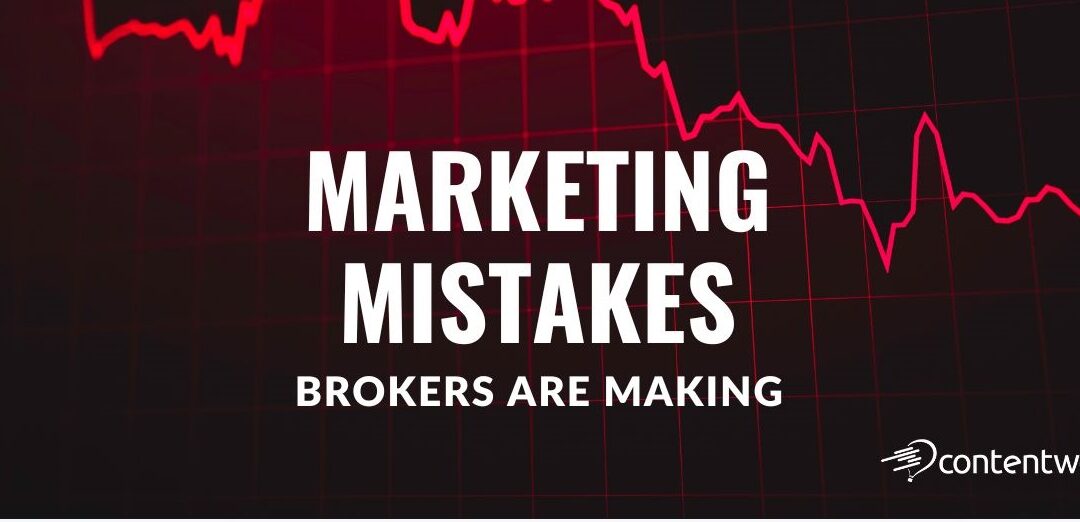The following is a guest editorial courtesy of Charlotte Day, Creative Director at Contentworks Agency.
Marketing your brokerage is becoming ever more challenging thanks to constant Google algorithm changes, tightening budgets, a rapid increase in competitors and complex regulations. As a financial services marketing agency we’ve experienced firsthand the many pitfalls you might come across. And, over the last two decades in the industry, we’ve seen (and possibly made) some blunders.
We asked our team to share some of their cringiest stories that have also left behind the biggest learning lessons. Here are some of the biggest mistakes brokers are making, so you don’t have to make them!
Strategy… What Strategy?
Niki Nikolaou, Director, Contentworks Agency
On the first day of my first ever FX job in 2006, I rocked up to HR for my orientation and asked for the department’s marketing plan. I got the “what planet are you from” look. What amazes me is that so many years later, I’m still coming across brokers that have no marketing plan. None. Zilch. Nada! I think it’s like getting in your car without knowing where you are going, why you’re going, the route to get there and what you expect to find at the end.
A solid marketing strategy for a broker sets goals and objectives, identifies and segments target markets, defines the marketing mix, and measures success. Creating a marketing strategy is crucial to ensuring everyone is on the same page. It should be accessible and refined throughout the year. I’ve seen so many resources wasted due to having no strategy, or not being consistent with the strategy created that is then filed in the bottom drawer.
Expanding Into New Markets Before You’re Ready

 Charlotte Day, Director, Contentworks Agency
Charlotte Day, Director, Contentworks Agency
As a broker you’re always on the look out for new trends and emerging markets to enter. We worked with a successful international broker a few years ago who decided to enter the African market (as everyone now is!). They did a lot of things right. They hired a local team, segmented the continent into regions and created targeted campaigns based on each country’s profile, worked closely with IBs and hit the road meeting their audience in person. Their marketing was spot on, it understood the messages to deliver, in which format and channel.
Where did they fail? The hadn’t set up robust payment systems in order to collect deposits and enable efficient withdrawals. And if a trader or affiliate cannot withdraw their funds quickly, you’re going to hear about it, as will everyone else on social media.
It seemed like such a small detail to not have ironed out before launching a massive campaign to enter the region. But once you lose trust, it’s hard to win it back. It’s also tough trying to regain a tarnished online reputation. My takeaway is simple. Get all your systems in place, from your techstack to your banking, legal and compliance. Once you’ve done that you can begin to rollout.
Looking to enter new markets? Download our our guide to emerging regions for forex brokers.
Throwing Money Away On Advertising

 Milton George, Head of PPC, Growth-onomics
Milton George, Head of PPC, Growth-onomics
From my experience, the most common mistake brokers make in performance marketing/media buy is failing to target specific markets and not allocating enough funds for initial testing. Successfully entering a new market requires a substantial budget to effectively test your creatives and offers. Spending only $2-3k is insufficient for drawing meaningful conclusions. As a result, brokers often spend a small budget, fail to see tangible results, and mistakenly conclude that either their ads or their offers are ineffective.
Another mistake some brokers make is starting with paid advertising before their website is performing optimally. What this means is having quality, engaging content that is branded and funnels the traffic received to the desired next action – be that a sign up to a demo, open live account, deposit etc.
Big Pretty Site That Doesn’t Do Its Job

 Nick Malekos, Head of SEO, Growth-onomics
Nick Malekos, Head of SEO, Growth-onomics
The biggest mistake in SEO is overusing Javascript creating heavy load websites with bad usability to users, that are difficult to read by search engines. Those are custom-made, beautiful websites, with very low usability, that often need redesigning from the ground up to work for SEO.
The best solution is working with an SEO expert early in the process or re-designing or re-launching a new website to ensure it is built correctly, rather than trying to fix it in the end.
Thinking AI Can Do All Your Content
Kate Palmer, Senior Content Manager, Contentworks Agency
There are many AI tools out there that you’ve probably been using for years. For creating content, AI can be great for research and brainstorming. But if you rely on it to generate all your content you’ll soon see generic, non-compliant content that can be incorrect and harmful to your brand. I mean, how often have you read emails that will “elevate your trading”? And that’s just an innocent example.
I was editing an article on how to use Candlesticks for a broker that was clearly using AI to generate the text, my job was just to check spelling and grammar. However, as I understand the ins and outs of trading, I came across some misinformation. It was telling traders that MACD is a leading indicator. I can understand why this mistake was made as you might assume that ‘leading’ means premier. However, in the world of techncial analysis, a ‘leading indicator’is data that helps forecast prices. MACD is clearly a lagging indicator that any trader worth their salt will tell you.
So yes, AI is a great tool to help you research, but final drafts should be checked by a human to ensure correctness, compliance, SEO, brand tone and uniqueness. Google is not being overly clear on ranking of AI generated content, but it is clear about E-E-A-T (Experience, Expertise, Authoritativeness, and Trustworthiness) score.
If you’re looking for fresh, relevant content, that is crucial for maintaining visibility and authority, book in for a 15 minute zoom with our team.
Assuming Your Forex Marketing Strategy Will Work For Prop Trading
Johan Visser, Finance Analyst, Contentworks Agency
We’re seeing more and more brokers offering prop trading, either under their own brand or as a separate brand. The most common mistake we’re seeing is the assumption that what you know about your forex trading audience can be taken across to your prop trading audience. A typical FX trader is looking for leverage, quick trades, high volatility, risk management. A prop trader is typically younger, less experienced and looking for education and community support. Prop trading requires less funds up front and takes off some of the mental pressure of trading. This means quite a different psychographic profile to what you might be used to.
As with all your target markets, segment them, research and get to know them. Here are some quick facts to better understand prop traders:
- As they are community driven, prop traders centre around YouTube, Discord, Instagram and other community and influencer driven networks
- 95.7% of prop traders are men with the average age in US being 43 years
- Again in the US, ethnicity of prop traders are anglo-saxon 66.1%, Asian 12.5%, Hispanic 11.6%, African American 5.5%
- Languages spoken in order – English, Spanish, Russian and Portuguese
- The prop space in 2020 was worth $6.7 bn globally with an annual growth rate (CAGR) of 4.2% from 2021-2028
- Regulators including CFTC are cracking down on prop trading, so ensure your communication is transparent and above board.
Support from a 360-agency
Overworked marketing departments are ripe for mistakes to happen. Utilising the support of a 360 degree marketing agency allows you to support different areas of your integrated marketing plan. It’s a scaleable solution that can work independently or as part of your overall team.
Speak with Contentworks about marketing for your forex or prop trading firm.









